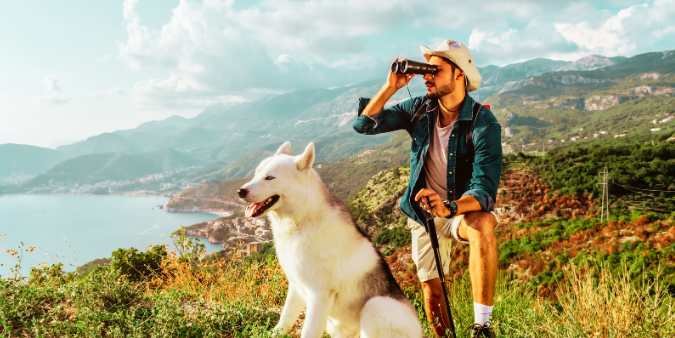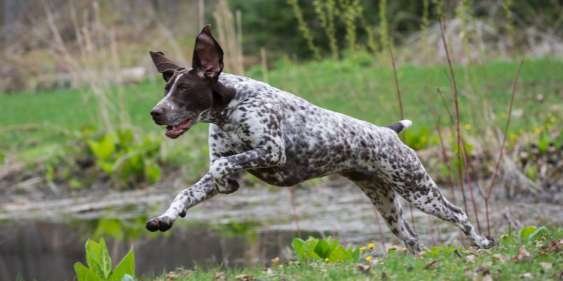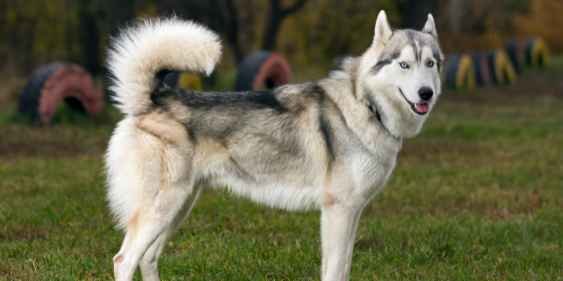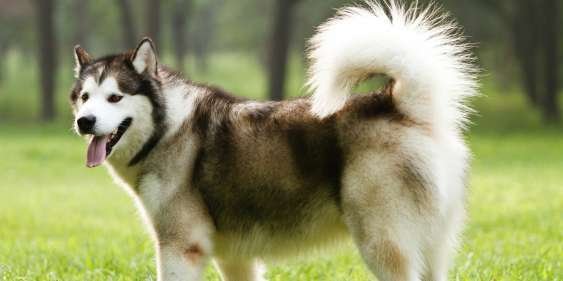We dog owners love adventure. Whenever we’re exploring, we want a pet that’s just as excited about it as we are. That’s where picking the best hiking dogs comes in. See, when you’re hitting the trails with your dog, it’s not just about their personality, it’s also about their physical attributes.
Some dog breeds are practically born for outdoor adventures. I’m talking about those breeds who can work hours long in any weather. They are super active and always have high energy. If you’re after an enthusiastic hiking buddy, you need to check out these dog breeds.

But hey, no matter which breed you end up with, always pack the right dog hiking gear and your necessary equipment. Safety first, right?
Now, let’s talk about why some dogs make such excellent hike companions. They’re not just pets. They’re like our adventure buddies! Sure, any physically fit dog will enjoy a walk with you, but not every dog is suited for those long, epic hikes.
Our best dogs for hiking guide will explore what makes a dog great for hiking and introduce you to some top breeds. You should consider if you’re looking for a new trail mate. So get ready to meet your next adventure partner.
11 Best Hiking Dogs Breeds
If you want a hiking buddy, check out these 20 dog breeds. Understand each breed’s traits and needs before deciding. Neglecting a dog’s needs can lead to problems and abandonment, which isn’t fair to the dog.
German Shorthaired Pointer

The German Shorthaired Pointer is an excellent hiking partner and belongs to the Sporting Group. Around the world, the breed is still used for hunting today as it was developed as a hunting dog. Suitable for long hikes and adventures, they enjoy long hours of strenuous activity in various climates.
Intelligent, athletic and energetic, these dogs come in mixed colours and patterns and are known for their beautiful (yet low maintenance!) sleek coats. The dogs are also excellent water dogs, and these attributes make him one of the best dog for hiking. Their social nature and willingness to please make them ideal for working with their owners and making new friends.
Siberian Husky

The Siberian Husky has a fascinating history, originally bred for the demanding task of pulling sledges and carts across vast distances in the challenging Russian climate. Renowned for their robust build and lively spirits, Siberian Huskies are always eager for adventure, making them ideal companions for outdoor enthusiasts.
No matter how long the journey, these dogs thrive on the energy and enthusiasm of long-distance hikes and treks. Though Siberian Huskies are adventurous, they remain gentle and attentive to their surroundings. Furthermore, they are highly social animals, enjoying their human companions’ company and time outside.
Bernese Mountain Dog

Bernese Mountain Dogs are majestic breeds, born in Switzerland’s Bernese Alps, and are known for their gentle nature and power. These dogs are well-suited for strenuous activities such as drafting and driving in cold mountainous terrain and are perfect hiking dogs. Their muscular physique and friendly nature make them ideal companions for outdoor enthusiasts. Although these dogs are adapted to the cold Alpine environment, it is essential not to overheat them in warmer conditions.
Australian Shepherd

The Australian Shepherd is a high-energy breed that thrives on outdoor adventures. Similar to its cousin, the Border Collie, the Aussie is known for its agility and herding instincts. They are hardworking and enjoy having tasks to fulfill, so engaging them in games during hikes provides them with both mental and physical stimulation. Regular exercise is essential for Aussies, as they require daily activity to stay happy and healthy. With proper training and ample exercise, Australian Shepherds make delightful companions and bring joy to their owners’ lives.
Golden Retriever

Golden Retrievers are generally intelligent and loyal dogs, known for their playful nature that lasts throughout their lives. They form strong bonds with their owners, respond well to commands, and thrive on an active lifestyle. Hiking and swimming are activities they particularly enjoy. However, they can be prone to joint problems, so it’s important to consult with your vet before embarking on rigorous hikes with them.
Vizsla

Vizslas are known for forming strong bonds with their owners and are loyal and task-oriented. Their intelligence requires consistent training and mental stimulation to prevent boredom and destructive behavior. With a need for space to run, they excel as hiking or trail running partners. Positive reinforcement and socialization are essential for grooming them into ideal companion pets. Patient and affectionate, Vizslas are great with children when introduced properly.
Labrador Retriever

The Labrador Retriever, much like the Golden Retriever, is a beloved and popular breed known for its intelligence, gentle nature, and trainability. Originally bred for retrieving game birds for hunters, Labradors also make excellent hiking companions due to their energy and stamina. They’re large dogs, slightly stockier than Golden Retrievers, with males reaching up to 24.5 inches tall and 80 pounds in weight.
Labradors are highly intelligent and easy to train, often chosen as service animals for their ability to follow commands and empathize with human emotions. They have gentle personalities, making them great pets for families with children and other animals. While they may be sensitive to loud noises, regular grooming helps manage their dense double coat and shedding.
Weimaraner

The Weimaraner is a hunting dog that enjoys spending lots of time outdoors, which is what they were originally bred for. They’re loyal, affectionate, and playful, making them great companions for various outdoor activities, including hiking. With their speed and stamina, they’re well-suited for both short and long adventures in nature.
Rhodesian Ridgeback

The Rhodesian Ridgeback is a dog from Africa that was used for hunting big animals. They’re active and proud dogs, a bit shy with strangers but loving with their family. They’re great for families who love being active outdoors, like hiking and climbing. But, they need training and getting used to meeting new people when they’re young. They’re strong and need someone who can handle them well.
Greyhound

Greyhounds are friendly pets that don’t need lots of exercise or space, making them great for apartments. They love lounging indoors but are happy to walk with you all day if they’re used to it. Since they’re built for speed, they can feel cold quickly, so they might need a coat in chilly weather. They’re big dogs, with males reaching up to 30 inches tall and 88 pounds.
Greyhounds are smart and can be trained, but they have a strong instinct to chase, so it’s best to keep them on a leash and muzzled around small animals until you’re sure of their behavior. They’re good with kids but might need supervision around smaller pets. Greyhounds can be startled by loud noises, so it’s important to help them get used to it. They don’t need much grooming, but they need plenty of exercise and a healthy diet to stay fit.
Alaskan Malamute

The Alaskan Malamute is a big, strong dog bred for pulling sleds and carts over long distances. They’re friendly and love being outside, especially when it’s cold. Their enthusiasm for outdoor activities, particularly in colder climates, is boundless. As true working dogs, Alaskan Malamutes thrive in rugged terrain and harsh weather conditions, making them excellent choices for hiking companions. Unlike some fast dogs, Malamutes are built for going long distances, so they’re perfect for really long hikes.
Training your Hiking Dog
Just as humans need training to tackle challenging hikes, so do dogs. Unless you adopt a dog already accustomed to an active lifestyle, training them for the trail is essential. This involves both physical conditioning and obedience training. However, some dogs may not respond well to training, especially those with a history of trauma or aggression. In such cases, professional dog behaviorists can offer specialized training to address these issues effectively.
Obedience training forms the foundation of preparing your dog for hiking. It teaches them to recognize and obey spoken commands, fostering a strong bond between you and your furry companion. Additionally, building your dog’s hiking endurance requires gradual progression from shorter, easier trails to longer and more challenging ones. It’s essential to understand your dog’s capabilities and limitations to ensure an enjoyable hiking experience for both of you. Moreover, practicing trail etiquette, including leash usage and cleaning up after your dog, is crucial to maintaining harmony on the trail and showing respect for fellow hikers and the environment.
FAQ’s
Can any dog be a hiking dog?
Any dog that’s physically able to do so will love to walk, and as such, you take any dog on the trail, however some dogs are inherently better suited to long hikes than others.
Do hiking dogs need training?
Yes, training is essential for hiking dogs. Just like humans, dogs need to learn how to behave on the trail and respond to commands. Training helps ensure that your dog stays safe and well-behaved while hiking. It teaches them important skills such as walking politely on a leash, coming when called, and staying focused in distracting environments. Additionally, training helps strengthen the bond between you and your furry companion, making the hiking experience more enjoyable for both of you.
Can Dogs Hike in snow?
Yes, dogs can hike in snow, but there are some considerations to keep in mind to ensure their safety and comfort. Firstly, it’s important to protect their paws from the cold and potential injuries from sharp objects hidden beneath the snow. Booties or paw wax can help provide insulation and traction.
Additionally, dogs should be dressed appropriately for the cold weather, especially if they have short fur or are prone to getting cold easily. It’s also essential to keep an eye on their body temperature and hydration levels, as they can still overheat and become dehydrated even in cold weather. Lastly, be mindful of their energy levels and any signs of fatigue or discomfort, and be prepared to shorten the hike if needed to ensure their well-being.
What should I take with me for my dog on a hike?
It all comes down to your dog’s preferences and the duration of your hike. Keep in mind that dogs can feel hot, cold, hungry, thirsty, and tired just like humans. Even on short hikes, it’s essential to bring extra water for your furry friend. Consider adding a dog backpack to carry supplies.
Conclusion
As we come to an end, let’s celebrate the amazing friendship dogs bring, not just on hikes but in our lives every day. For those of us who explore nature alone, having a dog makes the journey less lonely and more fun. Dogs seem to know when we need comfort, whether it’s a gentle nudge or a happy bark. It’s like they understand us without words, lifting our spirits when we’re feeling down.
Talk to anyone who loves dogs, and they’ll tell you stories that show just how special these furry friends are. The way they look at us with love, or how excited they get exploring new places, reminds us of the happiness they bring into our lives. That’s why many of us want to take our dogs with us when we go hiking. It’s not just about reaching the top of a hill—it’s about sharing the journey with a friend who’s always ready for an adventure.
In the end, hiking with dogs isn’t just about the trail. It’s about the moments we share together, and the memories we make along the way. Dogs have a way of turning an ordinary walk into something extraordinary, filling each step with their energy and love. So, here’s to our furry companions who remind us to enjoy life’s simple pleasures and cherish every moment we spend together on the trail.






